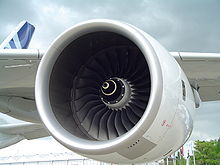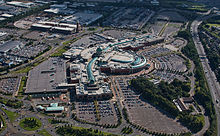Electricity, gas and water supply
The Blue Book 2013 reports that this sector added gross value of £33,289 million to the UK economy in 2011. The United Kingdom is expected to launch the building of new nuclear reactors to replace existing generators and to boost UK's energy reserves.
Manufacturing
In 2011 the UK manufacturing sector generated approximately £140,539 million in gross value added and employed around 2.6 million people. Of the approximately £16 billion invested in R&D by UK businesses in 2008, approximately £12 billion was by manufacturing businesses. In 2008, the UK was the sixth-largest manufacturer in the world measured by value of output.
In 2008 around 180,000 people in the UK were directly employed in the UK automotive manufacturing sector. In that year the sector had a turnover of £52.5 billion, generated £26.6 billion of exports and produced around 1.45 million passenger vehicles and 203,000 commercial vehicles. The UK is a major centre for engine manufacturing, and in 2008 around 3.16 million engines were produced in the country.
The aerospace industry of the UK is the second- or third-largest aerospace industry in the world, depending upon the method of measurement. The industry employs around 113,000 people directly and around 276,000 indirectly and has an annual turnover of around £20 billion. British companies with a major presence in the industry include BAE Systems (the world's second-largest defence contractor) and Rolls-Royce (the world's second-largest aircraft engine maker). Foreign aerospace companies active in the UK include EADS and its Airbus subsidiary, which employs over 13,000 people in the UK.
The pharmaceutical industry employs around 67,000 people in the UK and in 2007 contributed £8.4 billion to the UK's GDP and invested a total of £3.9 billion in research and development. In 2007 exports of pharmaceutical products from the UK totalled £14.6 billion, creating a trade surplus in pharmaceutical products of £4.3 billion.[91] The UK is home to GlaxoSmithKline and AstraZeneca, respectively the world's third- and seventh-largest pharmaceutical companies.
Mining and quarrying
The Blue Book 2013 reports that this sector added gross value of £31,380 million to the UK economy in 2011. In 2007 the UK had a total energy output of 9.5 quadrillion Btus, of which the composition was oil (38%), natural gas (36%), coal (13%), nuclear (11%) and other renewables (2%). In 2009, the UK produced 1.5 million barrels per day (bbl/d) of oil and consumed 1.7 million bbl/d. Production is now in decline and the UK has been a net importer of oil since 2005. As of 2010 the UK has around 3.1 billion barrels of proven crude oil reserves, the largest of any EU member state.
In 2009 the UK was the 13th largest producer of natural gas in the world and the largest producer in the EU. Production is now in decline and the UK has been a net importer of natural gas since 2004. In 2009 the UK produced 19.7 million tons of coal and consumed 60.2 million tons. In 2005 it had proven recoverable coal reserves of 171 million tons. It has been estimated that identified onshore areas have the potential to produce between 7 billion tonnes and 16 billion tonnes of coal through underground coal gasification (UCG). Based on current UK coal consumption, these volumes represent reserves that could last the UK between 200 and 400 years.
The UK is home to a number of large energy companies, including two of the six oil and gas "supermajors" – BPand Royal Dutch Shell – and BG Group.
Service industries
The service sector is the dominant sector of the UK economy, and contributes around 77.8% of GDP as of Q4 2013.
Creative industries
The creative industries accounted for 7% GVA in 2005 and grew at an average of 6% per annum between 1997 and 2005. Key areas include London and the North West of England which are the two largest creative industry clusters in Europe. According to the British Fashion Council, the fashion industry’s contribution to the UK economy in 2014 is ₤26 billion, up from ₤21 billion pounds in 2009.
Education, health and social work
According to The Blue Book 2013 the education sector added gross value of £84,556 million in 2011 whilst Human health and social work activities added £104,026 million in 2011.
In the UK the majority of the healthcare sector consists of the state funded and operated National Health Service (NHS), which accounts for over 80% of all healthcare spending in the UK and has a workforce of around 1.7 million, making it the largest employer in Europe, and putting it amongst the largest employers in the world. The NHS operates independently in each of the four constituent countries of the UK. The NHS in England is by far the largest of the four parts and had a turnover of £92.5 billion in 2008.
In 2007/08 higher education institutions in the UK had a total income of £23 billion and employed a total of 169,995 staff. In 2007/08 there were 2,306,000 higher education students in the UK (1,922,180 in England, 210,180 in Scotland, 125,540 in Wales and 48,200 in Northern Ireland).
Financial and business services
The UK financial services industry added gross value of £116,363 million to the UK economy in 2011. The UK's exports of financial and business services make a significant positive contribution towards the country's balance of payments.
London is a major centre for international business and commerce and is one of the three "command centres" of the global economy(alongside New York City and Tokyo). There are over 500 banks with offices in London, and it is the leading international centre for banking, insurance, Eurobonds, foreign exchange trading and energy futures. London's financial services industry is primarily based in the City of London and Canary Wharf. The City houses the London Stock Exchange, the London International Financial Futures and Options Exchange, the London Metal Exchange, Lloyds of London, and theBank of England. Canary Wharf began development in the 1980s and is now home to major financial institutions such as Barclays Bank, Citigroup and HSBC, as well as the UK Financial Services Authority.) London is also a major centre for other business and professional services, and four of the six largest law firms in the world are headquartered there.
Several other major UK cities have large financial sectors and related services. Edinburgh has one of the largest financial centres in Europe and is home to the headquarters of the Royal Bank of Scotland Groupand Standard Life. Leeds is now the UK's largest centre for business and financial services outside London, and the largest centre for legal services in the UK after London.
Hotels and restaurants
The Blue Book 2013 reports that this industry added gross value of £36,554 million to the UK economy in 2011.
Public administration and defence
The Blue Book 2013 reports that this sector added gross value of £70,400 million to the UK economy in 2011.
Real estate and renting activities
The real estate and renting activities sector includes the letting of dwellings and other related business support activities. The Blue Book 2013 reports that real estate industry added gross value of £143,641 million in 2011. Notable real estate companies in the United Kingdom include British Land and The Peel Group.
The UK property market boomed for the seven years up to 2008 and in some areas property trebled in value over that period. The increase in property prices had a number of causes: low interest rates, credit growth, economic growth, rapid growth in buy to-letproperty investment, foreign property investment in London andplanning restrictions on the supply of new housing.
Tourism
Tourism is very important to the British economy. With over 27 million tourists arriving in 2004, the United Kingdom is ranked as the sixth major tourist destination in the world. London, by a considerable margin, is the most visited city in the world with 15.6 million visitors in 2006, ahead of 2nd placed Bangkok (10.4 million visitors) and 3rd placed Paris (9.7 million).
Transport, storage and communication
The transport and storage industry added gross value of £59,179 million to the UK economy in 2011 and the telecommunication industry added a gross value of £25,098 million in the same year.
The UK has a radial road network of 46,904 kilometres (29,145 mi) of main roads, with a motorway network of 3,497 kilometres (2,173 mi). There are a further 213,750 kilometres (132,818 mi) of paved roads. The railway infrastructure companyNetwork Rail owns and operates the majority of the 16,116 km (10,014 mi) railway lines in Great Britain though not the rolling stock; a further 303 route km (189 route mi) in Northern Ireland is owned and operated by Northern Ireland Railways. Urban rail networks are well developed in major cities including Glasgow, Liverpool and London. Plans are now being considered to build new high speed lines linking all major cities by 2025.
The Highways Agency is the executive agency responsible for trunk roads and motorways in England apart from the privately owned and operated M6 Toll. The Department for Transport states that traffic congestion is one of the most serious transport problems and that it could cost England an extra £22 billion in wasted time by 2025 if left unchecked. According to the government-sponsored Eddington report of 2006, congestion is in danger of harming the economy, unless tackled by road pricing and expansion of the transport network.
In the year from October 2009 to September 2010 UK airports handled a total of 211.4 million passengers.In that period the three largest airports were London Heathrow Airport (65.6 million passengers), Gatwick Airport (31.5 million passengers) and London Stansted Airport (18.9 million passengers). London Heathrow Airport, located 24 kilometres (15 mi) west of the capital, has the most international passenger traffic of any airport in the world. and is the hub for the UK flag carrier British Airways, as well as BMI and Virgin Atlantic. London's six commercial airports form the world's largest city airport system measured by passenger traffic.





